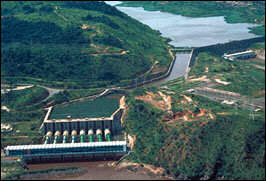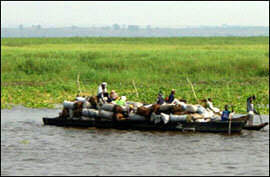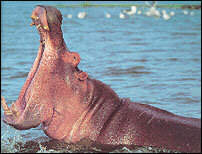 THE CONGO RIVER THE CONGO RIVER |
Physiography | Hydrology | Power | Transportation | Animal Life | Plant Life |
The Congo River In The Press
 Physiography Physiography
The Congo basin represents one of the most marked depressions to be found between the Sahara to its north, and the Atlantic Ocean to the south and west. It also includes the East African lakes to the east. Tributaries flow down slopes that vary from 900 to 1,500 feets into a central depression that forms the basin. It measures more than 1,200 miles north to south from the Congo-Lake Chad watershed to the Angolan plateaux. West to east (from the Atlantic to the Nile-Congo watershed) it also measures 1,200 miles.
The Congo basin has a large depression in the central portion. Referred to as a "cuvette", it is a large, shallow, saucer-shaped area. This depression contains Quaternary alluvial deposits which rest on thick sand and sandstone sediment of continental origin. Along the eastern edge of the cuvette outcrops of sandstone have formed. The cuvette has a filling that dates to Precambrian times (570 million years ago). Studies have shown that the sediment has built up over time from the erosion of the formations that surround the cuvette.
The Congo River system is composed of three distinct sections - the upper Congo, the middle Congo and the lower Congo.
The upper Congo contains confluences, lakes, waterfalls, and rapids. The Congo River has its beginnings in the Democratic Republic of the Congo where several small rivers unite. The Lualaba River and Luvua River join together and then continue on to the Boyoma (Stanley) Falls. Navigation is possible in the upper Congo by large vessels with low tonnage. Due to the rapids at headstreams and at various locations along the river navigation is interrupted and other means of transportation must be used.
Kisangani is situated downstream from the Boyoma Falls and is at the beginning of where the Congo River becomes navigable. For 1,000 miles the river flows towards Kinshasa. At first the river is narrow but soon widens as it enters the alluvial plain. From the point where the river widens, strings of islands occur which divide the river into different arms. The width of the Congo River can vary from 3.5 miles to 7 miles, reaching up to 8 miles at the mouth of the Mongala River. Along the banks of the river are natural levees which have been formed by deposits of silt. When the river floods these levees are washed away and the river boundaries are increased.
The middle Congo is characterized by the narrowing of the river. The banks are a half-mile to a mile apart, the river is much deeper and its current is faster. This section of the Congo is referred to as the Chenal (Channel) or Couloir (Corridor). It is along this stretch of the river that its principal tributaries flow into the Congo. They include the Ubangi River, Sangha River and the Kwa River. This results in a tremendous increase in the flow of water from 250,000 cubic feet per second at Kisangani to its maximum when it reaches Kinshasa.
From the middle Congo (Chenal) the river divides into two. One branch forms Malebo Pool, which is 15 miles by 17 miles large. This is the end of the middle Congo. Just downstream are the first of 30 waterfalls as the river continues to flow towards Matadi. At Matadi, the Congo's estuary begins in a narrow channel only half a mile to a mile wide. Eventually it widens below Boma but islands are once again a factor, dividing the river into several arms. The Congo now flows freely into the Atlantic Ocean.
Back to the top
 Hydrology Hydrology
The Congo River's flow and water levels are affected by the rains year round. It is the effect of rainfall throughout the regions (whose rivers and tributaries contribute to the Congo River) that influence the fluctuations in the flow of the river. However, because the Congo basin is an immense area, the weather pattern in one particular region will not have much effect on the river's overall levels. For example, heavy rainfall in the northern areas that contribute to the Ubangi River may cause flooding in the region itself, but would generally not lead to a drought in a southern portion of the Congo basin. Because of the vastness of the area, by the time the river's waters join together, very little effect will be seen. This allows the river's flow to balance out and not change too drastically during the year.
Patterns have been established in the past and the river can be expected to have higher levels in December and May due to the rainy season. The levels are expected to be low in March and April, and even lower in July in response to the dry season. If some of the weather patterns change drastically, resulting in floodwaters arriving at the same or different times, then the anticipated water levels will be affected accordingly. The flow has been recorded as high as 2,600,000 cubic feet per second during the flood of 1962. Its lowest level was recorded in 1905 at 765,000 cubic feet per second.
Back to the top

 Power Power
The Congo River is a potentially rich source of hydroelectric power. However, it is estimated that currently it represents only one-sixth of the world's known resources since the potential is not actually being exploited. So far, only two hydroelectric projects have been started in DRC (Zaire), the Inga I and Inga II. But even now, these two sites provide more power than DRC is able to consume at present.
Back to the top
 Transportation Transportation
The Congo River remains Africa's most vital navigational system. There are over 8,700 miles of waterway that are used in DRC (Zaire) alone. Barges carrying loads of 800 to 1,100 tons are able to navigate at least 650 miles of the Congo throughout the year. These barges carry fuel, wood, minerals and agricultural products and are a communication and transportation resource for those areas that are not served by roads.

There are three main transportation routes, which come together downstream at Kinshasa on the Malebo Pool. These three routes have their origins in three places: Kisangani, Ilebo (on the Kasai River), and Bangui (on the Ubangi River). These routes have continued to aid economic development in those areas that are further inland and do not have access to the coast for shipping, etc.
Although certain sections of the river can be used for transportation, it is unnavigable in its lower reaches, where there are numerous waterfalls. To facilitate transportation to the coastal regions along the Atlantic Ocean, railway systems have been built to complete the routes inland.
The river system in some areas is a drawback. There are only a few bridges that cross the Congo and its tributaries at present. This problem can only be solved in the future with cooperation and funds provided by the countries through which the river flows.
Back to the top
 Animal Life Animal Life
The Congo basin's wildlife lives in the Congolese forest and is very different from the wildlife found in Africa's savanna grasslands. In addition to the wildlife found in the forest are the creatures that inhabit the waters of the Congo. There are many species of fish throughout (over 200 species exist in the Malebo Pool). There are also forms of wildlife inhabiting the marshes that have nothing to do with the wildlife in the river.

| Several species of water snakes and various reptiles, notably the crocodile, live along the banks of the river. One can also find tortoise that are semiaquatic.
The birds that live in this region are indigenous to the African continent. Throughout the region surrounding the Congo River over 250 species of birds have been noted. The birdlife which is most abundant includes ducks, herons, storks, and pelicans. At different times of the year, birds not typically found in the forest have been observed. For example the sea swallows will fly upstream from the Atlantic Ocean. Other birds from Europe have also been observed while following their migratory routes through the region.
Few aquatic mammals live in the Congo. They are represented by the hippopotamus, otter, and the manatee (which has only been found in the Sangha tributary).
Back to the top
 Plant Life Plant Life
The Congo Basin's climate is considered to be equatorial, this results in a densely forested area. The trees are primarily evergreens and they are found throughout the basin's central depression. There are occasional clearings found in the forest, however. These clearings are natural in origin and have not been cleared by humans. Bordering the forest are savanna grasslands which blend into the forest along its edges.
The Congo River runs through these forests, which are called the Congolese forests. Along the banks are strips of grass and meadows which contain Echinochloa (barnyard grass), papyrus and Cyperaceae (sedge). Beyond the levees the high forest grows and in-between, the Alchornea shrub grows, indicating the transition from grassland back to forest.
Back to the top
 THE CONGO RIVER IN THE PRESS THE CONGO RIVER IN THE PRESS
The Congo River by David Johnson
The mighty Congo River Africa's second longest, is one of the world's purest major rivers, according to a recent survey. Although it is heavily used for travel, the Congo remains relatively unpolluted because there are few industrial centers along its banks. In contrast, the longest river in the world, the Nile, is seriously polluted by agricultural irrigation, industrial waste and sewage. In addition, much of the Nile's potential flow is lost through evaporation, largely from reservoirs.
The findings were made by the World Commission on Water for the 21st Century, a Paris-based organization supported by the World Bank and the United Nations. The group studied 500 of the world's major rivers and offered a generally pessimistic appraisal. "More than one-half of the world's major rivers are being seriously depleted and polluted, degrading and poisoning the surrounding ecosystems, thus threatening the health and livelihood of people who depend upon them for irrigation, drinking and industrial water," the study reported.
According to the commission, water pollution and the subsequent environmental degradation are largely responsible for the existence of some 25 million environmental refugees worldwide (as compared to 21 million refugees who flee war), people leaving their homes in search of cleaner places to live.
Experts say the quality and amount of river water can be increased through international cooperation to make more efficient use of resources and reduce pollution. The commission also urged that everyone be guaranteed access to clean water. The Amazon in South America ranked alongside the Congo as an exceptionally clean major river. On the other hand, seriously polluted and overused waterways include the Yellow River in China, the Colorado River in the United States, and the Amu Darya and Syr Darya Rivers in Russia and Central Asia.
Although it is relatively pristine, the Congo and its tributaries have nonetheless long been the traditional highways of central Africa. Altogether the Congo River comprises 10,000 miles of waterways, which flow past varied topography including dense tropical forests. The Kongo people are believed to have begun settling along its banks in the twelfth century, eventually forging a large empire with the river as its heart. The Kongo Kingdom lasted for several hundred years. The arrival of the Portuguese in 1483 and the rise of the slave trade weakened the Kongo state until it broke into factions following battles with the Europeans in 1665.
However, the Kongo remained influential throughout the colonial era and today are a major ethnic group in both the Democratic Republic of the Congo, the former Zaire, and in the Republic of the Congo, often called Congo-Brazzaville.
The Congo River has also played an important role in recent political upheavals in both nations. In May 1997, deposed dictator Mobutu Sese Seko left Kinshasa, Zaire, and fled across the river to Brazzaville, in the Republic of the Congo to escape the army of Laurent-Désiré Kabila. A few months later, the flight was in the opposite direction, as thousands of supporters of ousted President Pascal Lissouba used boats to avoid the army of General Denis Sassou-Nguesso, which had entered Brazzaville and proclaimed a new government. One of the strange ironies of the river's relative cleanliness is the fact that political strife and corruption have stunted development in both Congos for decades, with successive regimes placing little emphasis on building industries which would boost the nations' economies, and, paradoxically, cause greater pollution of the river.
In the west, the Congo River has long been seen as a romantic symbol of exotic central Africa, which Victorians called "darkest Africa." In the 1870's, explorers David Livingstone and Henry M. Stanley traveled throughout the Congo basin. Shortly thereafter, Joseph Conrad sailed along the Congo and immortalized the river in his novel, Heart of Darkness. The river was also used by a less sympathetic westerner, Belgian King Leopold II, who mercilessly looted the region in the late nineteenth century. Tons of rubber, ivory, gold and other treasures were floated down the Congo and shipped off to Europe in a staggering process of colonial exploitation which was enforced with a brutality that killed millions of the people living along the Congo's banks.
Back to the top
 "Congo River reopened to traffic" By Mark Dummett in Kinshasa "Congo River reopened to traffic" By Mark Dummett in Kinshasa
BBC News
The United Nations Security Council has announced the reopening of the Congo River to commercial traffic, a vital thoroughfare which has been blocked for two-and-a-half years as a result of the war in the Democratic Republic of Congo.
In a country with few decent roads, hardly any working railways and exorbitantly expensive airlines, the rivers in DR Congo are important transport routes. The UN humanitarian office in Kinshasa has said that the blocking of river traffic has left many in the capital starving. But the world's third largest river has been cut in two by the front line that divides government forces and their foreign allies and rebels backed by Uganda and Rwanda.
 Economic renaissance Economic renaissance
Rather than ferrying essential foodstuffs down to the capital, Kinshasa, it has been the scene of some of the heaviest fighting between the two sides. That now is about to change. According to French ambassador Jean-David Levitte, who is leading a delegation of 12 members of the Security Council to all countries involved in the Congolese war, the river is now officially open. He said it would lead to a renaissance in the devastated economy of the country. A UN boat carrying fuel to the city of Kisangani will be the first to cross the front line, on 8 June, and the Uruguayan navy will be supplying 250 men to patrol sensitive points along the river.
 Long-held goal Long-held goal
The opening of the Congo has for long been a goal of the UN, which has been monitoring a ceasefire and pushing the belligerents towards lasting peace. The Security Council moves on from Congo to Zambia on Monday, where they will be meeting all the parties to the ceasefire agreement. There they are hoping for something even more important to Congo's well-being - finalised plans for the withdrawal of all foreign armies.
 Troops Troops
Meanwhile, Congolese President Joseph Kabila has expressed disappointment with the level of UN troop contributions to his country. He said about 20,000 peacekeeping troops were needed to support peace efforts. The UN has so far deployed 1,300 troops to Congo.
Back to the top |

